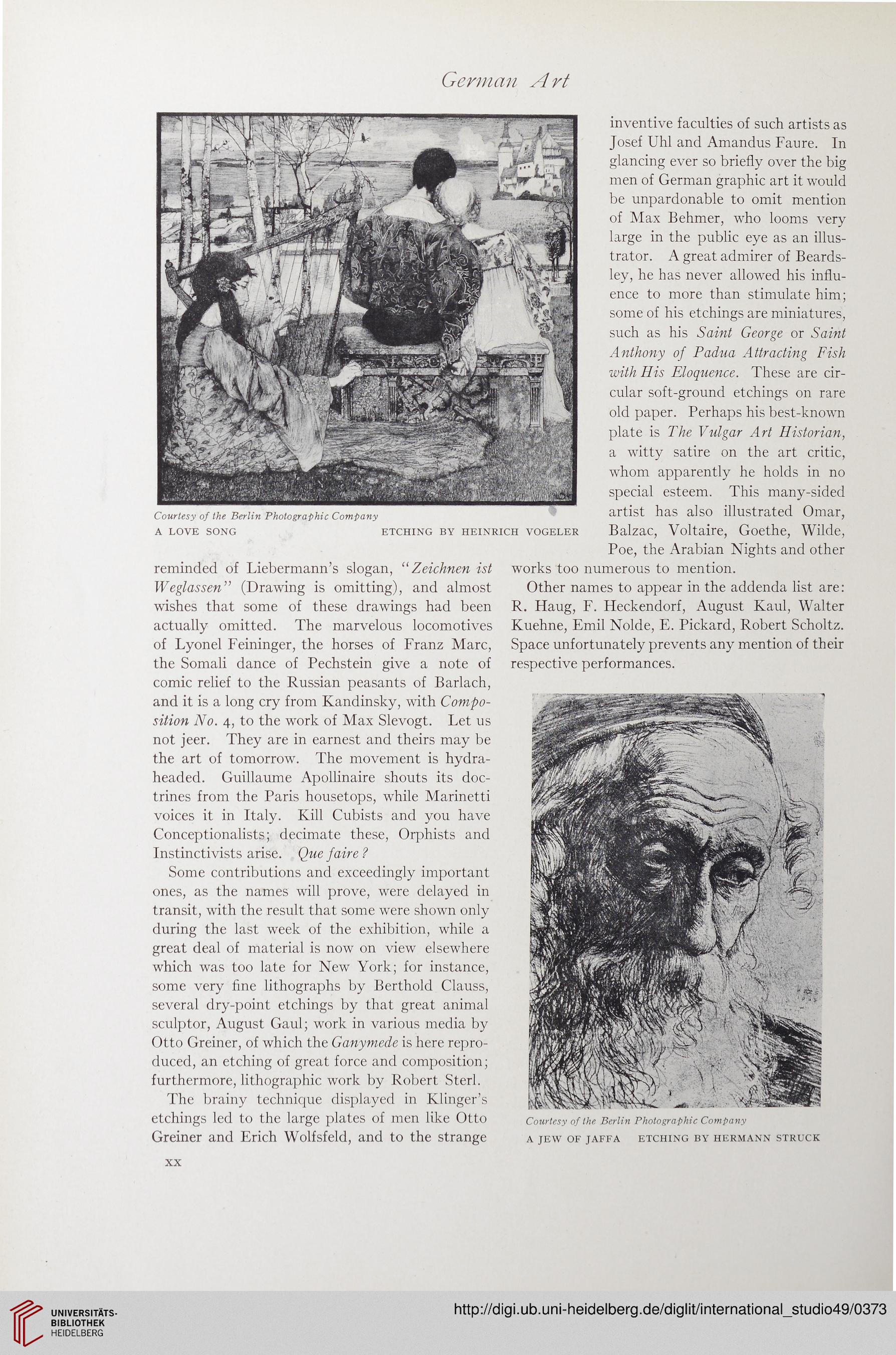German Art
Courtesy of the Berlin Photographic Company
A LOVE SONG
ETCHING BY HEINRICH VOGELER
reminded of Liebermann’s slogan, “ Zeichnen ist
Weglassen” (Drawing is omitting), and almost
wishes that some of these drawings had been
actually omitted. The marvelous locomotives
of Lyonel Feininger, the horses of Franz Marc,
the Somali dance of Pechstein give a note of
comic relief to the Russian peasants of Barlach,
and it is a long cry from Kandinsky, with Compo-
sition No. 4, to the work of Max Slevogt. Let us
not jeer. They are in earnest and theirs may be
the art of tomorrow. The movement is hydra-
headed. Guillaume Apollinaire shouts its doc-
trines from the Paris housetops, while Marinetti
voices it in Italy. Kill Cubists and you have
Conceptionalists; decimate these, Orphists and
Instinctivists arise. Que faire ?
Some contributions and exceedingly important
ones, as the names will prove, were delayed in
transit, with the result that some were shown only
during the last week of the exhibition, while a
great deal of material is now on view elsewhere
which was too late for New York; for instance,
some very fine lithographs by Berthold Clauss,
several dry-point etchings by that great animal
sculptor, August Gaul; work in various media by
Otto Greiner, of which the Ganymede is here repro-
duced, an etching of great force and composition;
furthermore, lithographic work by Robert Sterl.
The brainy technique displayed in Klinger’s
etchings led to the large plates of men like Otto
Greiner and Erich Wolfsfeld, and to the strange
inventive faculties of such artists as
Josef Uhl and Amandus Faure. In
glancing ever so briefly over the big
men of German graphic art it would
be unpardonable to omit mention
of Max Behmer, who looms very
large in the public eye as an illus-
trator. A great admirer of Beards-
ley, he has never allowed his influ-
ence to more than stimulate him;
some of his etchings are miniatures,
such as his Saint George or Saint
Anthony of Padua Attracting Fish
with His Eloquence. These are cir-
cular soft-ground etchings on rare
old paper. Perhaps his best-known
plate is The Vulgar Art Historian,
a witty satire on the art critic,
whom apparently he holds in no
special esteem. This many-sided
artist has also illustrated Omar,
Balzac, Voltaire, Goethe, Wilde,
Poe, the Arabian Nights and other
works too numerous to mention.
Other names to appear in the addenda list are:
R. Haug, F. Heckendorf, August Kaul, Walter
Kuehne, Emil Nolde, E. Pickard, Robert Scholtz.
Space unfortunately prevents any mention of their
respective performances.
Courtesy of the Berlin Photographic Company
A JEW OF JAFFA ETCHING BY HERMANN STRUCK
XX
Courtesy of the Berlin Photographic Company
A LOVE SONG
ETCHING BY HEINRICH VOGELER
reminded of Liebermann’s slogan, “ Zeichnen ist
Weglassen” (Drawing is omitting), and almost
wishes that some of these drawings had been
actually omitted. The marvelous locomotives
of Lyonel Feininger, the horses of Franz Marc,
the Somali dance of Pechstein give a note of
comic relief to the Russian peasants of Barlach,
and it is a long cry from Kandinsky, with Compo-
sition No. 4, to the work of Max Slevogt. Let us
not jeer. They are in earnest and theirs may be
the art of tomorrow. The movement is hydra-
headed. Guillaume Apollinaire shouts its doc-
trines from the Paris housetops, while Marinetti
voices it in Italy. Kill Cubists and you have
Conceptionalists; decimate these, Orphists and
Instinctivists arise. Que faire ?
Some contributions and exceedingly important
ones, as the names will prove, were delayed in
transit, with the result that some were shown only
during the last week of the exhibition, while a
great deal of material is now on view elsewhere
which was too late for New York; for instance,
some very fine lithographs by Berthold Clauss,
several dry-point etchings by that great animal
sculptor, August Gaul; work in various media by
Otto Greiner, of which the Ganymede is here repro-
duced, an etching of great force and composition;
furthermore, lithographic work by Robert Sterl.
The brainy technique displayed in Klinger’s
etchings led to the large plates of men like Otto
Greiner and Erich Wolfsfeld, and to the strange
inventive faculties of such artists as
Josef Uhl and Amandus Faure. In
glancing ever so briefly over the big
men of German graphic art it would
be unpardonable to omit mention
of Max Behmer, who looms very
large in the public eye as an illus-
trator. A great admirer of Beards-
ley, he has never allowed his influ-
ence to more than stimulate him;
some of his etchings are miniatures,
such as his Saint George or Saint
Anthony of Padua Attracting Fish
with His Eloquence. These are cir-
cular soft-ground etchings on rare
old paper. Perhaps his best-known
plate is The Vulgar Art Historian,
a witty satire on the art critic,
whom apparently he holds in no
special esteem. This many-sided
artist has also illustrated Omar,
Balzac, Voltaire, Goethe, Wilde,
Poe, the Arabian Nights and other
works too numerous to mention.
Other names to appear in the addenda list are:
R. Haug, F. Heckendorf, August Kaul, Walter
Kuehne, Emil Nolde, E. Pickard, Robert Scholtz.
Space unfortunately prevents any mention of their
respective performances.
Courtesy of the Berlin Photographic Company
A JEW OF JAFFA ETCHING BY HERMANN STRUCK
XX




